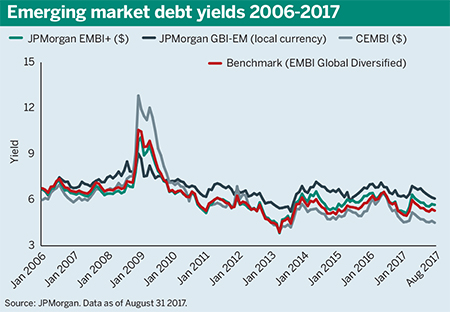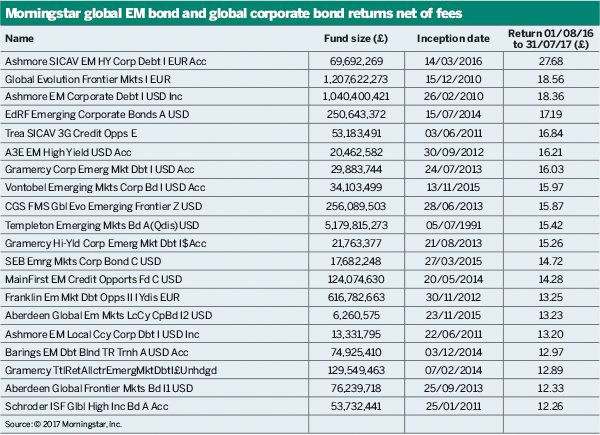Emerging market debt has performed well during the past six to 12 months, and while the asset class attracts investors in their search for yield, schemes should continue to brace themselves for volatility.
The mood has lightened since then, with emerging market debt performing particularly well in recent months.
Sometimes that contagion effect can move outwards and affect the whole asset class – it has that potential
Allison Galbraith, Hymans Robertson
Investors turn to EMD for yield
“Emerging market performance had been in the doldrums since the taper tantrum around 2013, where emerging market debt and equities just underperformed developed markets,” notes Colin Cartwright, partner at consultancy Aon Hewitt.
However, during the past six to 12 months, “that has reversed a little bit, and emerging markets have done well” by outperforming their developed counterparts, he says.
Allison Galbraith, an investment research consultant at Hymans Robertson, agrees the trend from both hard and local currency, throughout 2017 and towards the end of 2016, “has been one of good performance”.
The yield on JPMorgan’s Emerging Market Bond Index, which tracks hard currency debt, currently stands at 5.5 per cent, while the yield on the JPMorgan Government Bond Index-Emerging Markets Global Diversified Traded Index is around 6 per cent, comparing favourably with the UK 10-year gilt yield of about 1 per cent, or 10-year US Treasury yield at roughly 2 per cent.

The low-yield environment has prompted many UK schemes to search for higher returns over the past few years.
Galbraith notes there have been strong inflows into EMD, which has helped to push prices up.
“Pension funds in particular… have been searching for yield in the low-yield environment that we’ve seen from developed sovereigns,” she says.
Similarly, Colm McDonagh, head of emerging market fixed income at Insight Investment, highlights that “liquidity conditions globally are quite good, and certainly the inflows into the asset class have really begun to pick up again... in the second half of last year, and certainly this year it’s been very strong”.
Generally, emerging market assets began to perform much better in 2016, McDonagh says.
“One of the main drivers has clearly been the differential in emerging market growth relative to developed market growth,” he says.
Risks remain
McDonagh points to the particularly positive performance in local markets. “You can see some very attractive positive real interest rates in EM economies, there’s… certainly not very much inflation risk, and as a result a number of these economies are beginning to have the luxury to cut interest rates,” he says.
But while performance has been promising, how long is it likely to last? And what sort of effect could political turmoil in, for example, Venezuela have?
“There are still risks in the asset class,” Galbraith says, noting that it has specific countries within it that have the potential for political instability.
But the market is currently quite positive, “so what tends to happen is that the underperformance – for example in Venezuela – is confined to Venezuela”, she notes.

In a more negative environment, where investors are nervous, “sometimes that contagion effect can move outwards and affect the whole asset class – it has that potential”, she adds.
McDonagh agrees that “Venezuela in itself has tremendous problems and restructuring is very likely”. However, he does not think it poses a systemic risk.
“For a very long time Venezuela’s been flagged. It’s certainly priced appropriately, trading around default levels or recovery levels,” he says.
Still under-represented in pension fund portfolios
Cartwright says EMD is still under-represented in institutional investors’ portfolios. “There is scope to allocate more to emerging market asset classes,” he says, noting that schemes can access EMD directly, through dedicated mandates, or via multi-asset credit strategies.
Matthew Michael, product director, emerging market debt and commodities at asset manager Schroders, says EMD is currently attractive due to good valuations and improved liquidity in a number of areas. However, he says investors “often come in and out of the asset class at the wrong time”.
And the asset class is “still subject to boom and bust phases, as you would expect”, Michael says. Despite being in a post-crisis recovery period, “you will, from time to time, have countries still going through their crises”, he says.
Look out for part two next week














